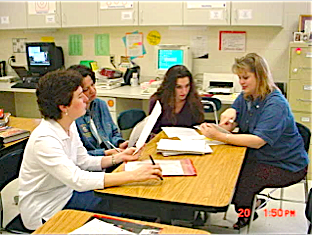7 Time-Saving Ways to Balance Teaching Tasks
 By Barbara R. Blackburn
By Barbara R. Blackburn
How do you manage to do everything you need to do to be an effective teacher? There is no doubt that this is the number one concern I hear from teachers. With everything you must juggle, it can seem overwhelming.
I’m often asked what would be my ideal solution. That’s easy. I’d schedule every Friday as a professional day, providing ample time for teachers to work together to plan, assess, learn new ideas, and improve teaching. Unfortunately, that is not reality for most of us, and I don’t have a magic wand. So, what do we do?
Long term, I would encourage you to advocate for what you need, whether it is resources or planning time, on an ongoing basis. However, while you are working to change the situation, there are strategies that will help you make the most of your current status.
Strategy 1: Accept that you will never have as much time or resources as you would like.
I continue to find that, no matter how much I have to do, I always need more time. I told a friend of mine once that I wished I had 48 hours per day. She replied, if that happened, you would end up with double the work!
I find inspiration from Maya Angelou: If you don’t like something, change it. If you can’t change it, change your attitude. Don’t complain. (But do advocate. There’s a difference. When we advocate, we make the case that what we are asking is not just for ourselves but for the success of our students and our school.)
Strategy 2: Accept that the quest for perfectionism may be your enemy.
I have realized that there are times my expectations for myself are too high, and are, at times, unrealistic. I’ve also found that to be true with many teachers. They spend hours on the internet looking for ideas to create the perfect lesson plan, when they probably could have accomplished just as much if they had stopped much earlier.
I’m not recommending you provide sloppy instruction. What I am saying is that most of the time, 80% of excellence is still very, very good. If it takes you double or triple the time to gain that additional 20%, it’s probably not worth it because of all the other tasks you didn’t accomplish. Share your time fairly with all your priority tasks.
Strategy 3: Work with other teachers.

Working with the two other teachers who also teach the same subject and grade level, you divide the work. You write the interactive study guide that some students will need for this unit. Your neighbor writes one for Unit 3, and the teacher down the hall is going on maternity leave, but volunteers to create one for Unit 6 when she returns. Yes, it takes time for you to write one, but you end up with three when you share, which saves you time in the long run.
Strategy 4: Create a Personal Learning Network.
Sometimes you and your colleagues will need other ideas. I spoke with a teacher who waited until the last minute to plan lessons, then frantically googled for ideas. If you have ever done that, you know that you have to filter through a lot of mediocre ideas before you find ones you like.
Instead, consider creating your own Personal Learning Network (PLN). It’s a way of using the Internet and social media to manage your own learning and to organize the information you receive. PLNs are not new. Often, they are just networks of professional contacts, but with social media it’s possible to add experts and colleagues from around the world to your network. (Edublogs has created an excellent free self-paced activity to help teachers develop a PLN.)
Strategy 5: Work smarter, not harder.
You’ve probably heard this before, but it is true. Far too often we spend extra time on our work because we can’t find something we need, or we don’t remember something we wanted to change this year. It is absolutely critical to stay organized so that we streamline what we do.

When I was a teacher, I addressed the first option by writing notes on my plans. The problem was that I wasn’t organized enough to find all my notes when I needed them. Now, to keep up with resources I want to use in the future, I use folders for organization. I keep paper folders, folders in my email, and bookmark folders for my browser, all of which include resources and information I can use. One tip I’ve learned is that I need to have specific topics on folders, rather than just a miscellaneous one which makes it more difficult to find resources.
In terms of recurring tasks, I currently use a to-do list app that allows me to check a box if it occurs regularly, and it automatically schedules it (for example, on the last day of the month). A friend of mine, Frank Buck, provides practical ideas and resources on organization and time management, especially using technology, on his website: www.frankbuck.org. You can also find his ideas among these MiddleWeb articles. You might start here. (First-year teachers will definitely want to read Frank’s “A New Teacher’s Big List of All the Little Things.”)
Strategy 6: Remember that small changes lead to bigger ones.
Far too often, we think that if we are implementing something new, we need to change everything we are doing. If you remember the old fable, the turtle finished before the hare in the race. Start slowly, implementing an idea or two at a time, rather than throwing out everything you have been doing and starting over. Begin with two tiers one day each week, then increase them over time. Regular progress is the goal.
Strategy 7: Keep balance in your life.

Set a time to leave at the end of the day and stick to it unless there is an emergency. If you need to take work home at night or on the weekend, set a limit of how long you will work and stick to it. Do your job effectively but make time for yourself. You’re not helping your students when you become weary and mentally exhausted.
A Final Note
Balancing all your responsibilities as a teacher is a daunting challenge. However, with a plan for organizing your time and resources you can feel less overwhelmed.
____________________________




































Great tips, Barbara! I especially like your reminder about it being okay to not be perfect all the time. I often remind myself that though the saying goes, “Good is the enemy of great”, the reciprocal, “Great is the enemy of good” is equally true.
Great advice! Building a powerful PLN really resonates with me. You can only do so much alone. But together the possibilities are endless.